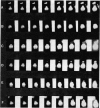Abstract
Customary procedures used to determine chromosomal inheritance do not disclose many of the chromosomal polymorphisms known to be present, resulting in uninformative families. The sequential printing of individual chromosomes presented here is a technique that has increased the number of informative families in our studies. This technique has revealed previously unseen heritable chromosome differences and allowed the designation of parental origin.
Full text
PDF


Images in this article
Selected References
These references are in PubMed. This may not be the complete list of references from this article.
- Caspersson T., Lomakka G., Zech L. The 24 fluorescence patterns of the human metaphase chromosomes - distinguishing characters and variability. Hereditas. 1972;67(1):89–102. doi: 10.1111/j.1601-5223.1971.tb02363.x. [DOI] [PubMed] [Google Scholar]
- MOORHEAD P. S., NOWELL P. C., MELLMAN W. J., BATTIPS D. M., HUNGERFORD D. A. Chromosome preparations of leukocytes cultured from human peripheral blood. Exp Cell Res. 1960 Sep;20:613–616. doi: 10.1016/0014-4827(60)90138-5. [DOI] [PubMed] [Google Scholar]
- Robinson J. A. Origin of extra chromosome in trisomy 21. Lancet. 1973 Jan 20;1(7795):131–133. doi: 10.1016/s0140-6736(73)90198-0. [DOI] [PubMed] [Google Scholar]
- Smith G. F., Sachdeva S. Origin of extra chromosome in trisomy 21. Lancet. 1973 Mar 3;1(7801):487–487. doi: 10.1016/s0140-6736(73)91915-6. [DOI] [PubMed] [Google Scholar]



